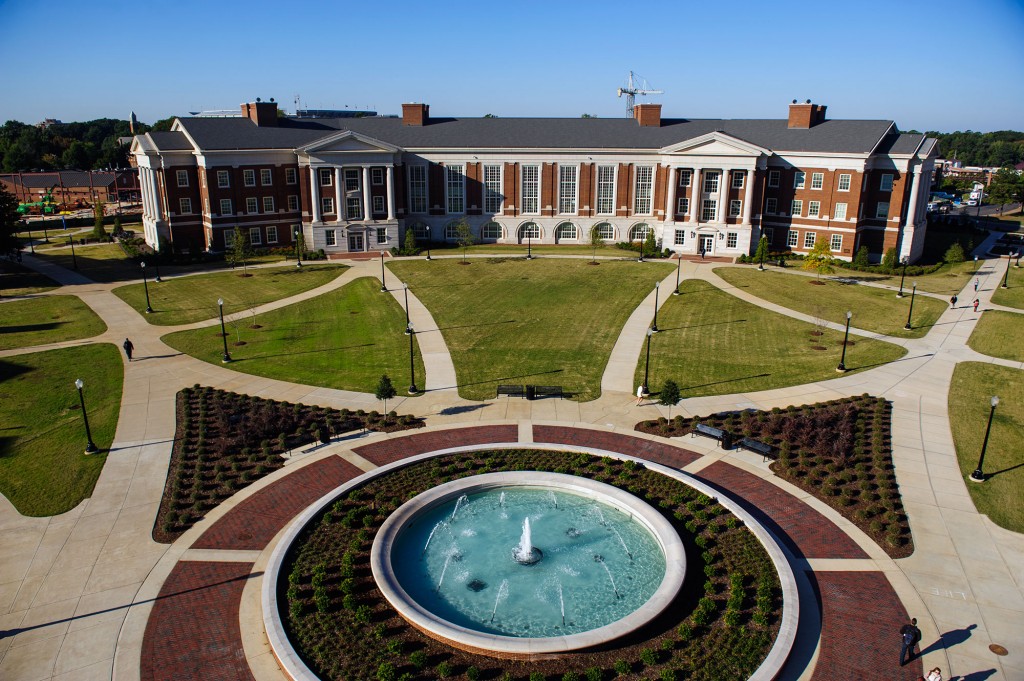 The Central Analytical Facility
The Central Analytical Facility
The University of Alabama’s Central Analytical Facility houses more than $10M of micro-analytical and microscopy equipment. The CAF is a general user facility – with access to on and off campus users. It is staffed with a full time laboratory manager and instrumentation specialists who provide training and maintenance of the instruments, in conjunction with manufacturer service contracts ensuring that all tools are functioning and operating within specifications. The range of instruments can provide 1D, 2D and 3D imaging from the atomic scale to millimeters. In addition, several of the tools can provide chemical mapping and crystallographic orientation and diffraction capabilities. The CAF instruments and techniques include a local electrode atom probe, focused ion beam microscopes, transmission electron microscope, scanning electron and microprobe microscopes, X-ray photon spectroscopy, and X-ray diffraction. Learn more about the Central Analytical Facility
Composite Materials Laboratories
Several laboratories are used to fabricate and test composite materials. The facilities include various presses and environmental chambers. Various materials can be synthetized, including new compositions with carbon nanotubes, carbon nano-fibers, and biodegradable elements. The strength and dynamic response of composites can be tested under various conditions, including impact loading, or as a function of environmental effects (moisture, temperature).
The Electromechanical Systems Lab (EMSyL)
The Electromechanical Systems Lab (EMSyL) focuses on high-power motion control and energy conversion system development and integration topics such as thrust vector control systems, flight surface control systems, renewable resource generation, and hybrid/electric vehicles. The facility houses state-of-the-art development, fabrication, prototyping, testing, and instrumentation equipment. EMSyL research focuses on system integration and components of modern electromechanical devices and systems including power electronics, electric machinery, advanced energy storage, renewable resources, system-level control, and design optimization.
The Engines and Combustion Lab (ECL)
The Engines and Combustion Lab (ECL) is a premier facility in the South Engineering Research Center. The ECL consists of 11,000 square feet of high-bay space partitioned into six test cells, four instrument rooms between the test cells, two large work rooms, a central hallway, and substantial storage space. One large test cell houses a two-roller chassis dynamometer capable of measuring power output of front, rear, or four-wheel-drive vehicles up to 14,000 pounds gross vehicle weight and up to 350 hp per axle. The other large test cell houses an AC engine dynamometer rated at 650 hp and up to 1360 ft-lbf torque. Emissions equipment includes a dilution tunnel and five-gas emissions analyzers for raw and diluted samples, plus particulates, capable of handling the exhaust of a 650 hp diesel engine at full load. Other available ECL instrumentation includes a fast-response Cambustion CLD500 NOx analyzer, fast-response TSI EEPS Particulate Spectrum and Number (PSN) analyzer, Thermo-Scientific REGA Fourier Transform Infrared (FTIR) spectrometer with heated sample line, fast-response (1 ms/amu) V&F AIRSENSE mass spectrometer, Cambustion HFR400 Fast-FID hydrocarbon analyzer, Koehler Instruments K45000 distillation analyzer, and a gas chromatograph system for product-gas analysis. Laser-based diagnostic instruments available are several Particle Image Velocimetry (PIV) systems, including a time-resolved stereoscopic PIV system, a standard, low-speed PIV system, and a TSI Volumetric 3-component Velocimetry (V3V) system for 3D velocity-field measurements. Also available is a high-speed TSI Planar Laser-Induced Fluorescence (PLIF) system for time-resolved combustion species measurements. Other optical diagnostic systems include a quantitative rainbow Schlieren apparatus for whole-field scalar measurements, Schlieren, shadowgraph, and holographic interferometry systems for spray and flame imaging, a Laser-Doppler Velocimetry (LDV) system for velocity and turbulence measurements, and a Phase-Doppler Particle Analyzer (PDPA) system for point measurements of drop size/velocity.
Integrated Manufacturing Laboratory
This laboratory is used to develop process modeling, simulation (FEM), and optimization for manufacturing. Mechanical behavior of materials is investigated. In addition, sensor-based intelligent monitoring and controlled systems as well as concurrent simulation-based design and manufacturing software are developed. The laboratory is equipped with several CNC machining centers, high performance computers, and related software packages.
Interdisciplinary Electrochemistry Laboratory
The Interdisciplinary Electrochemistry Laboratory houses state-of-the-art equipment for research in fuel cells, batteries, photovoltaics, electrolysis, hydrogen storage, and catalytic science (for fuel synthesis or pre-treatment, or exhaust after-treatment). It includes in particular a rotating-disk electrode to analyze the performance of electrocatalysts, a fuel-cell test station, a Differential Electrochemical Mass Spectrometer, a Hiden CatLab catalytic microreactor, etc. Researchers in this field also have access to the Central Analytical Facility (see below).
Research Foundry
The Ray L. Farabee Metalcasting Laboratory, or experimental foundry, is a world class experimental facility, considered by most foundry metallurgists (also known as solidification scientists) to be comparable to the famous academic foundry at Aachen, Germany.
Structural Acoustics Laboratory (STAL) and Reconfigurable Hemi-Anechoic Chamber
The College of Engineering has a reconfigurable hemi-anechoic chamber. While in the hemi-anechoic configuration, the chamber was recently verified by an independent third party to meet ISO 3745:2003 specifications at frequencies down to 80 Hz. The facility is large enough to accommodate a large pick-up truck. Learn more about the Structural Acoustics Laboratory